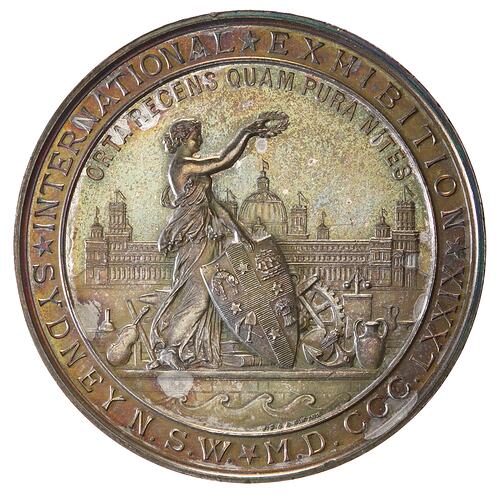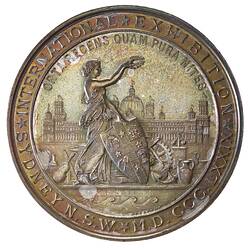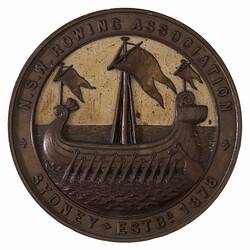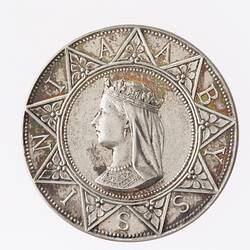Summary
Australia New South Wales Sydney
International Exhibition Prize 1879 - 1880 (AD)
Mint: Sydney
Awarded to: Not issued
Other Details: A small silver prize medal (51 mm) featuring a view of the imposing Sydney Garden Palace Exhibition Building, built to house the International Exhibition. The medal includes an allegorical figure of New South Wales standing in front holding the colonial shield and surrounded by exhibition goods. This is a specimen striking collected by the Melbourne Mint and may have been exhibited by them at the Melbourne International Exhibition in 1880. The small rim knick at obv. 12 may have been made by a mounting pin at that time. The Sydney International Exhibition was the first true international exhibition that an Australian colony had hosted. Previous exhibitions had been local or intercolonial. The International Exhibition was held in a purpose-built building at Inner Domain, featuring 15 acres of display area and a main dome 210 feet high. Four towers of this 'Garden Palace' provided spectacular views of the city and harbour, and the galleries were illuminated with stained glass skylights. The Exhibition was opened by His Excellency Lord Augustus Loftus on 17 September 1879, whose arrival in Sydney from England the previous month as the new Governor of New South Wales had been received with great enthusiasm. The Exhibition attracted over 1.1 million visitors, at a time when the population of New South Wales was 739,385. Awards for exhibitors were announced by the judges on the closing day, 20 April 1880. Gold, large silver, small silver and bronze medals and diplomas were awarded. The medal's obverse was based on a design by Samuel Begg and subsequently altered by J.S. and A.B. Wyon, who prepared the dies. The wreath of Australian flowers on the reverse was designed by James W. Sayers. The gold and silver medals were struck at the Sydney branch of the Royal Mint, and the bronze medals were struck in London. About 7,554 awards were made. The exhibition was so popular that the government purchased many of the prize exhibits and set up the Technological, Industrial and Sanitary Museum, the grandparent of the Powerhouse Museum. The Garden Palace burned down in 1882.
Physical Description
A small silver prize medal (51 mm) struck at the Sydney Mint from dies supplied by J.S. & A.B. Wyon of London. It features a view of the Sydney Garden Palace Exhibition Building with a figure of New South Wales standing in front holding the colonial shield and surrounded by exhibition goods. This is a specimen striking collected by the Melbourne Mint and may have been exhibited by them at the Melbourne International Exhibition in 1880. The small rim knick at obv. 12 may have been made by a mounting pin at that time.
Obverse Description
Figure of New South Wales surrounded by works of industry before exhibition building; around, * INTERNATIONAL * EXHIBITION * SYDNEY N.S.W.* M.D.CCC.LXXIX in exergue, waves, below these waves in tiny letters the artists names, J.S. & A.B. WYON
Reverse Description
Wreath of Australian native flora below, J.S.& A.B. WYON (On issued medals the winner's name etc. engraved in the central space)
Edge Description
Plain
Significance
The Sydney International Exhibition was the first true international exhibition that an Australian colony had hosted. Previous exhibitions had been local or intercolonial. The International Exhibition was held in a purpose-built building at Inner Domain, featuring 15 acres of display area and a main dome 210 feet high. Four towers of this 'Garden Palace' provided spectacular views of the city and harbour, and the galleries were illuminated with stained glass skylights. The Exhibition was opened by His Excellency Lord Augustus Loftus on 17 September 1879, whose arrival in Sydney from England the previous month as the new Governor of New South Wales had been received with great enthusiasm. The Exhibition attracted over 1.1 million visitors, at a time when the population of New South Wales was 739,385. Awards for exhibitors were announced by the judges on the closing day, 20 April 1880. Gold, large silver, small silver and bronze medals and diplomas were awarded. The medal's obverse was based on a design by Samuel Begg and subsequently altered by J.S. and A.B. Wyon, who prepared the dies. The wreath of Australian flowers on the reverse was designed by James W. Sayers. The gold and silver medals were struck at the Sydney branch of the Royal Mint, and the bronze medals were struck in London. About 7,554 awards were made. The Garden Palace burned down in 1882. - Carlisle, Leslie J. 1978. Australia's First International Exhibition: Sydney 1879. Report of the Australian Numismatic Society. Yearbook No.3; Australian Dictionary of Biography. -D. Tout-Smith 11/11/2003.
The Sydney International Exhibition of 1879 included an extensive display of the handiwork of the children of NSW. This Sydney Juvenile Industrial Exhibition was organised by the Council of Education, with the schools of the colony contributing numerous exhibits, principally of crayon drawings, maps, illuminations and needlework. In all, the children won some six hundred awards, 'bearing testimony to the general merit of their handiwork' (from 'Official Record of the Sydney International Exhibition', 1881). -Powerhouse Museum web site http://www.phm.gov.au/scripts/webdbs/opac.idc?id=441. -D. Tout-Smith 20/10/2003.
More Information
-
Collecting Areas
-
Acquisition Information
Transfer from Melbourne Branch of Royal Mint, 11 Jan 1978
-
Date Issued
1879-1880 AD
-
Issued By
Australian International Exhibition Commissioners, Sydney, Greater Sydney, New South Wales, Australia, 1879-1880
-
Mint
Royal Mint, Sydney Branch, Sydney, Greater Sydney, New South Wales, Australia, 1879
-
Artist
Joseph S. Wyon, 23 Regent Street, London, England, Great Britain
-
Artist
-
Artist
-
Artist
-
Inscriptions
Plain (edge) Figure of New South Wales surrounded by works of industry before exhibition building; around, *INTERNATIONAL*EXHIBITION* SYDNEY N.S.W.* etc. (obverse) Wreath of Australian native flora below, J.S.& A.B. WYON (reverse)
-
Series
-
Material
Silver
-
Axis
12
-
Classification
-
Category
-
Discipline
-
Type of item
-
Dimensions
51 mm (Outside Diameter), 61.23 g (Weight)
-
Shape
Round
-
References
Hock.p.261
[Article] Carlisle, Leslie J. 1978. Australia's First International Exhibition: Sydney 1879. Report of the Australian Numismatic Society. Yearbook No.3: 22-31.
[Book] Proudfoot, Peter, et al. 2000. Colonial City, Global City: Sydney's International Exhibition 1879.
[Book] 1881. Official Record of the Sydney International Exhibition, 1879. 1154.
-
Keywords





